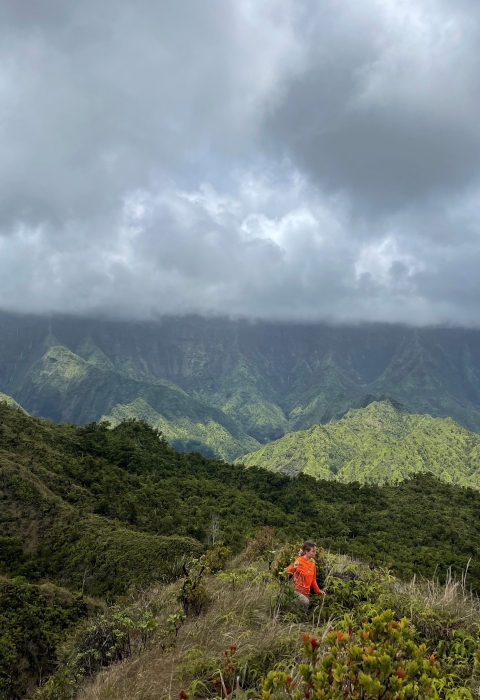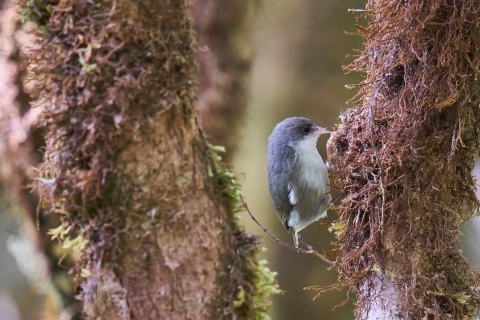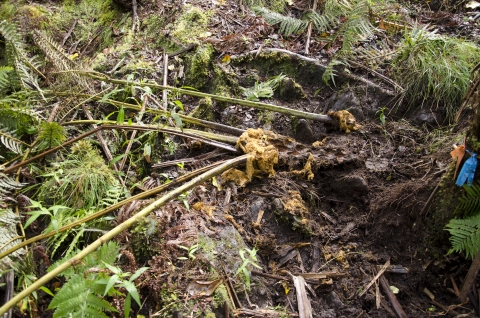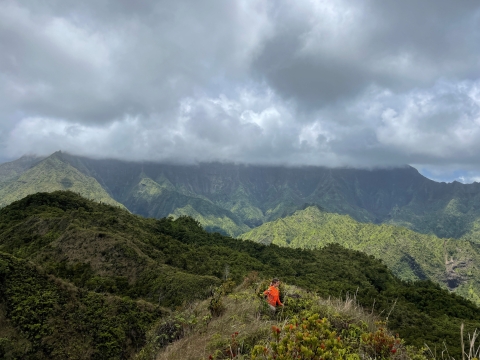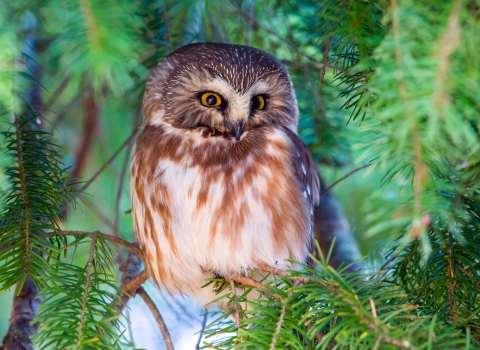There are two main strategies for controlling invasive game mammals throughout the Hawaiian Islands: putting up fences and hunting. Hunting for non-native feral pigs, axis deer, black-tailed deer, feral goats, and other introduced game mammals is an important cultural, recreational, and subsistence activity in many communities. However, these species can have negative impacts on the native and endangered flora and fauna of the Pacific Islands. Maintaining a public hunting program for these game mammals that does not threaten native species and ecosystems in Hawai‘i is a complex endeavor. With funding through the Wildlife and Sportfish Restoration Program, the Division of Forestry and Wildlife (DOFAW) at Hawai’i’s Department of Land and Natural Resources is using island wide surveys to study what areas the game mammals are using, how to manage existing hunting areas, and even how hunting could be a tool to protect sensitive species and ecosystems.
Hawai’i’s Department of Land and Natural Resources and DOFAW manages game mammal hunting opportunities on six major islands in the state of Hawai‘i: Kaua‘i, O‘ahu, Maui, Moloka‘i, Lana‘i and the big island of Hawai‘i. Each of these islands has one or more state-designated public hunting areas, which are open for hunting at certain times during each year. Hunting is also permitted on private land with a valid hunting license and landowner permission. “Game mammal hunting in Hawai‘i is unique because all of the hunted species are non-native to the area,” said Jason Omick, wildlife biologist for DOFAW’s Division of Forestry. “Our agency works not only to provide safe and accessible hunting, but also to understand what impact these game mammals can have on native species, including many listed plant and bird species.”
Surveying Kauaʻi Through Animal Signs and Camera Footage
Kauaʻi is the most recent island to complete this Wildlife Restoration Grant funded survey of feral game species. The survey was conducted in 2020 and 2021 by completing sign surveys, a relative abundance estimate survey that uses both the amount of animal signs (droppings, tracks, etc), and number of captures from game cameras to estimate game mammal abundance. Survey locations were selected using a random stratified sampling design across elevational gradients across the island. This included remote areas on both public and private land, some of which was only accessible via helicopter. “The random site selection and elevational coverage allowed us to take a holistic view of where game mammals were during different times of the year and if these species favor different habitat types, like native vegetation,” said Derek Risch, Spatial Planner & Research Coordinator, at the University of Hawaiʻi ‘s Price Lab. Risch has been with the project since the beginning, working across O’ahu, Maui, and Kauaʻi to survey each island and create a data resource for many potential conservation uses. “By conducting a comprehensive survey of game mammal distribution, preferred habitat, and seasonal variation of these animals, state agencies, conservation groups, landowners, and hunters can see where these game mammals are, and this could have implications on how resources and species are managed.”
These efforts have allowed DOFAW to plan and institute strategic changes to utilize hunting to control game mammals and lessen the impacts they can have on native species. “We had anecdotal accounts that said that game species were increasing or expanding into certain areas, but these surveys provide an in-depth review of what is happening at an island scale,” said Omick. “With this data we have already made changes to hunting season length, bag limits, and areas open to hunting.” One such place that has seen this change is Kauaʻi’s Unit F along the island’s Mokihana Ridge where the open hunting days were changed from Friday through Monday and state holidays to daily after the survey showed a high population of game species using the area. These findings were also supported by real time observations provided by local hunters. Kauaʻi’s approximately 2,000 licensed hunters now have more opportunities to hunt while contributing to island conservation for endangered species like the 'akikiki, a small Hawaiian honeycreeper bird, and rare native plants such as the Aupaka (Isodendrion laurifolium).
The 'akikiki, only found on Kauaʻi’, is negatively impacted by feral pigs and other introduced mammals because these mammals can increase mosquito populations. As these mammals’ forage, they create mosquito breeding habitat when knocking over and hollowing out troughs in native tree ferns making rain-filled wallow breeding habitats for mosquitoes. Increases in mosquito habitat can propel the avian malaria disease cycle. Avian malaria is a deadly disease and major concern for biologists working to save forest birds across the Hawaiian Islands. Kauaʻi’s rare plant species like the Aupaka, an endangered violet, are impacted as introduced mammals feed on the plant and disturb the surrounding area allowing invasive plants to take root and compete with the native species.
Connection to Ongoing Rapid ʻŌhiʻa Death Research
Other areas Omick suggests this survey data could be used is in conjunction with ongoing Rapid ʻŌhiʻa Death research. ʻŌhiʻa (Metrosideros polymorpha), a native Hawaiian tree, is dying from a new fungal disease that attacks the tree’s ability to move water through the sapwood to the leaves. On the Island of Hawaiʻi, over a million ʻōhiʻa have already died from this fungus, known as Ceratocystis. Healthy trees appear to die within a few days to a few weeks of showing symptoms, which is how the disease came to be called “Rapid ʻŌhiʻa Death.” ʻŌhiʻa are a keystone species, comprising significant portions of all Hawai‘i’s native forests and ʻōhiʻa’s nectar producing flowers are a vital food source for native forest birds, as well as habitat. New research suggests that feral pigs and other game mammals can increase the spread of the disease as they forage around tree roots and scrape away tree bark allowing the fatal fungus to enter the plant. “Research at its core is neutral, these surveys tell us where the game mammals are,” said Melissa Price, Associate Professor for the Department of Natural Resources & Environmental Management at the University of Hawai‘i at Mānoa. “But when we overlay this with areas like sensitive ecosystems, listed species range, species at risk of disease, the survey becomes a powerful tool to highlight areas that could have high hunting value.”
Next Steps for Survey Use and Expansion
Price points out that these surveys are also important for items not found on biological maps. “We can multitask, with challenges like food and economic insecurity, species conservation, landowner challenges, and hunters wanting access to the outdoors, this project can bring together everyone that needs to be talking,” added Price. Across the Hawaiian landscape everyone can play a role in stewardship, and it is important to provide communities the scientific data needed to make timely and strategic stewardship decisions.
The Pacific Islands are home to over 40 percent of the threatened and endangered species listed under the Endangered Species Act with unique species found nowhere else in the world. As these islands face a changing climate, habitat loss, and challenges like species restoration and disease outbreaks, the data from these surveys can highlight areas of high hunting value where hunters and increased hunting pressure could be a strategic resource for island stewardship. Risch and his team from the University of Hawaiʻi have begun work to conduct the next game mammal survey on the Island of Hawaiʻi. The biggest survey to date, this survey will expand the available data to DOFAW and communities to support planning and strategic steps for conservation and hunting in the future.
